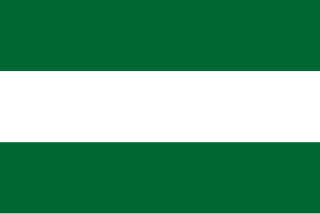
The Durrani Empire or the Afghan Empire, also known as the Sadozai Kingdom, was an Afghan empire that was founded by Ahmad Shah Durrani in 1747, that spanned parts of Central Asia, the Iranian plateau, and the Indian Subcontinent. At its peak, it ruled over the present-day Afghanistan, much of Pakistan, parts of northeastern and southeastern Iran, eastern Turkmenistan, and northwestern India. Next to the Ottoman Empire, the Durrani Empire is considered to be among the most significant Islamic Empires of the 18th century.

European influence in Afghanistan has been present in the country since the Victorian era, when the competing imperial powers of Britain and Russia contested for control over Afghanistan as part of the Great Game.

Emir Dost Mohammad Khan Barakzai, nicknamed the Amir-i Kabir, was the founder of the Barakzai dynasty and one of the prominent rulers of Afghanistan during the First Anglo-Afghan War. With the decline of the Durrani dynasty, he became the Emir of Afghanistan in 1826. He was the 11th son of Payendah Khan, chief of the Barakzai Pashtuns, who was killed in 1799 by King Zaman Shah Durrani.
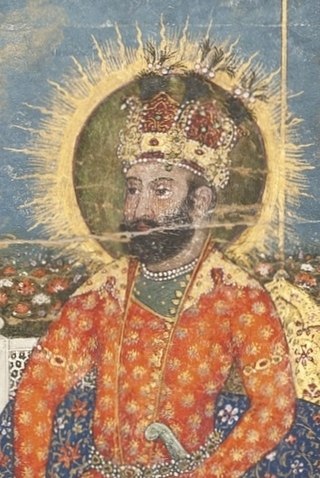
Zaman Shah Durrani, or Zaman Shah Abdali, was ruler of the Durrani Empire from 1793 until 1801. He was the grandson of Ahmad Shah Durrani and the fifth son of Timur Shah Durrani. An ethnic Pashtun of the Sadozai clan, Zaman Shah became the third King of the Durrani Empire.

Mahmud Shah Durrani ; 1769 – April 18, 1829) was born Prince and later ruler of the Durrani Empire (Afghanistan) between 1801 and 1803, and again between 1809 and 1818. From 1818 to 1829 he was the ruler of Herat. An ethnic Sadduzai tribe section of the Popalzai sub clan of the Durrani Pashtuns, he was the son of Timur Shah Durrani and grandson of Ahmad Shah Durrani.

Sardar Mohammad Azim Khan Barakzai was a Pashtun noble who served as Afghan governor of Kashmir (1812–1819). He was the second son of the Barakzai chief Payinda Sarfaraz Khan, while his elder brother Fateh Khan was kingmaker and Vizier to Mahmud Shah Durrani. He was one of 21 brothers from eight mothers including his half-brother Dost Mohammad Khan who would later become Emir of Afghanistan.

The Battle of Kabul was part of a punitive campaign undertaken by the British against the Afghans following the disastrous retreat from Kabul. Two British and East India Company armies advanced on the Afghan capital from Kandahar and Jalalabad to avenge the complete annihilation of the British-Indian military-civilian column in January 1842. Having recovered prisoners captured during the retreat, the British demolished parts of Kabul before withdrawing to India. The action was the concluding engagement to the First Anglo-Afghan War.

Alakozai is a Pashtun tribe in Afghanistan. They are one of the four tribes of the Zirak tribal confederacy of Durrani Pashtuns.
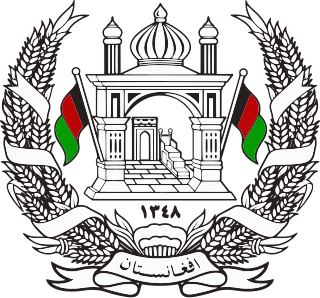
The Barakzai dynasty also known as the Muhammadzai dynasty ruled modern day Afghanistan from 1823 to 1978 when the monarchy ended de jure under Musahiban Mohammad Zahir Shah and de facto under his cousin Sardar Mohammad Daoud Khan. The Barakzai dynasty was established by Dost Mohammad Khan after the Durrani dynasty of Ahmad Shah Durrani was removed from power. As the Pahlavi era in Iran, the Muhammadzai era was known for its progressivist modernity in which Afghanistan was referred to as the "Switzerland of South Asia".

The Afghan–Sikh Wars spanned from 1748 to 1837 in the Indian subcontinent, and saw multiple phases of fighting between the Durrani Empire and the Sikh Empire, mainly in and around Punjab region. The conflict's origins stemmed from the days of the Dal Khalsa, and continued after the Emirate of Kabul succeeded the Durrani Empire.

Timur Shah Durrani, also known as Timur Shah Abdali or Taimur Shah Abdali was the second ruler of the Afghan Durrani Empire, from November 1772 until his death in 1793. An ethnic Pashtun, he was the second eldest son of Ahmad Shah Durrani.
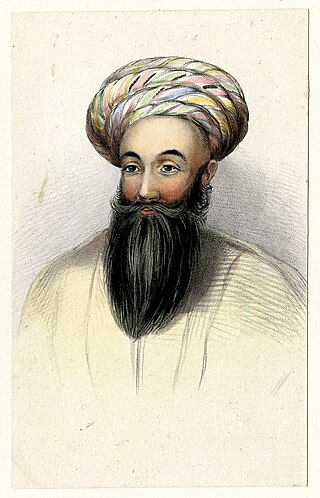
Padshah Sultan Shah Shuja Durrani was ruler of the Durrani Empire from 1803 to 1809. He then ruled from 1839 until his death in 1842. Son of Timur Shah Durrani, Shuja Shah was of the Sadduzai line of the Abdali group of ethnic Pashtuns. He became the fifth King of the Durrani Empire.

The Principality of Herat, the Emirate of Herat, the Herat Khanate or simply Herat was a state in Afghanistan from 1793 to 1863, and one of the 3 main khanates in 19th century Afghanistan.
The Battle of Nimla took place between June–July 1809, due to a conflict between Mahmud Shah Durrani and Shah Shuja Durrani over the succession for the Durrani throne. The battle resulted in a victory for Mahmud Shah and allowed him to secure the throne, where he reigned from 1809 to 1818. This was his second reign before he was deposed.
The Parwan Campaign took place from October–November 1840, as a result of Dost Mohammad Khan's rebellion against Shah Shuja and the British backed regime. The Parwan campaign had over 13 different clashes, and ended in an Afghan victory, with Robert Sale forced to abandon the campaign and return to Kabul.
The Hazarajat Campaign of 1843 began as a result of the post First Anglo-Afghan War situation in Afghanistan. Behsud and Bamiyan had broken away from Afghan rule as a result of the war, and Dost Mohammad sought to reconquer it following his resumption of power in Kabul.
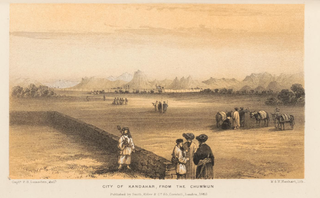
The Conquest of Kandahar took place on 14 November 1855, and its consolidation lasted as long as September 1856. Following the death of Kohandil Khan, the ruler of Kandahar under the Dil brothers, the region had fallen into a succession crisis between Rahmdil Khan, the brother of Kohandil, and Kohandil's sons, who wished to gain power for themselves. Dost Mohammad Khan, the ruler of the Emirate of Afghanistan, sought to take advantage of the anarchy and chaos, and conquer Kandahar for himself.
The Afghan Turkestan Campaign of 1838-39 began in the winter of 1838 and ended in March 1839. The campaign was sent as a result of the tyranny of the Qunduz Khanate's ruler, Murad Beg. It was also launched for reasons such as additional revenue gain and tribute from many of the Uzbek states present in the region, including an attempt at subjugating the prominent states of Khulm and Qataghan. Dost Mohammad also feared the rise of Murad beg and that the Qunduz Khanate was slowly enroaching on Bamiyan.
Dost Mohammad's Campaign to Jalalabad (1834) took place in Early 1834, prior to the summer invasion of Shah Shuja Durrani in Kandahar. Dost Mohammad Khan wished to raise troops and subjugate the regions around Jalalabad, which was ruled by many different polities, one of the most significant being Mohammad Zaman Khan, who was centred in Jalalabad. This invasion from Dost Mohammad would be opposed by the rulers of Kunar, and the Mohmand tribe.
Fateh Khan Barakzai or Wazir Fateh Khan or simply, Fateh Khan, was Wazir of the Durrani Empire during the reign of Mahmud Shah Durrani until his torture and execution at the hands of Kamran Shah Durrani, the son of the ruler of the Durrani Empire, and Mahmud Shah Durrani, and other prominent conspirators such as Ata Mohammad Khan. Fateh Khan was of the Barakzai tribe, and his death caused the enmity of his tribe, leading to his tribe revolting and the eventual deposition of Mahmud Shah Durrani.











